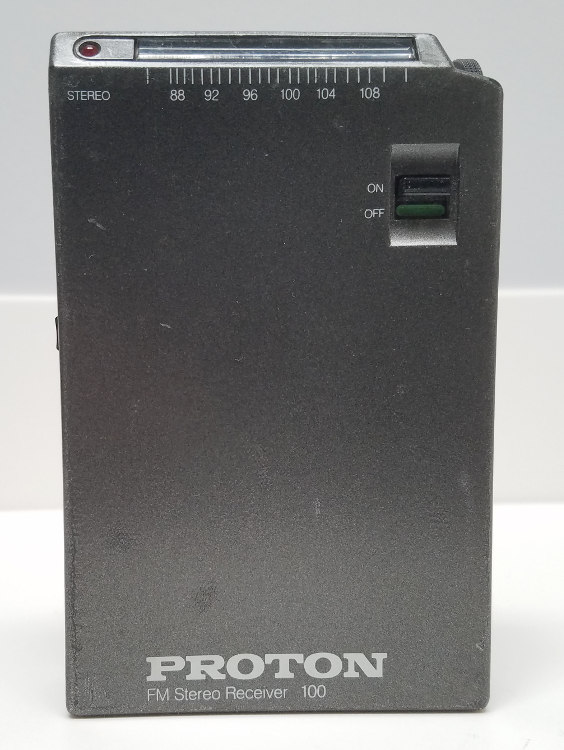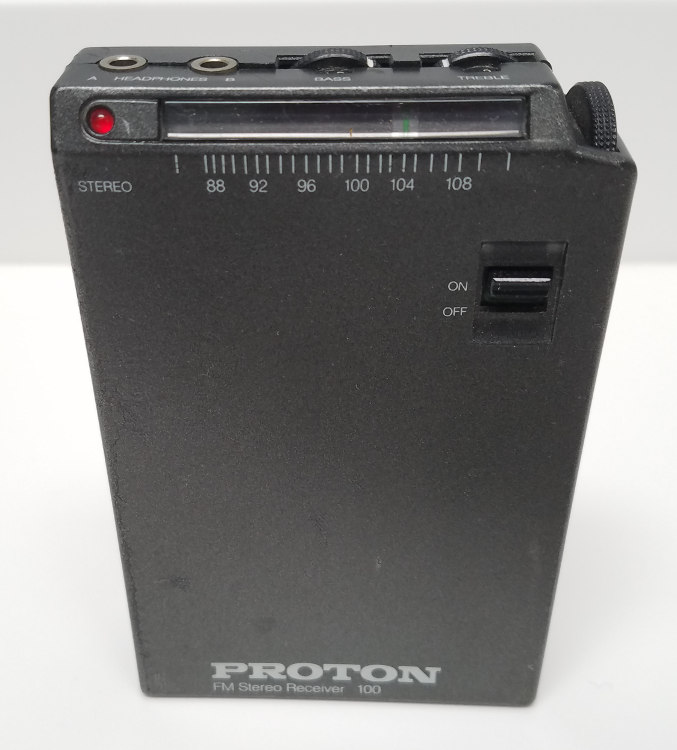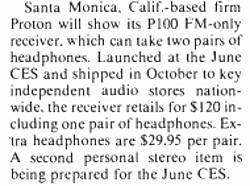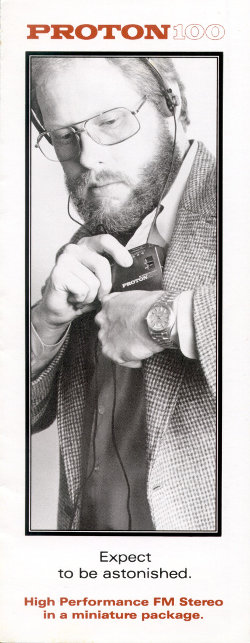

While the Sony Walkman's original concept was that of a cassette player, with listening exclusively through headphones, by 1981 headphone-only radios began appearing. Possibly pre-dating even Sony's own SRF-40W was the Proton 100 FM-only radio.

High-fidelity-oriented publications such as Audio or Stereo Review didn't give much if any coverage to Walkman units of any kind. One has to turn to Billboard to get at least a peek into the early days of Walkman-style radios, including the Proton 100. The excerpt at left from Billboard in 1982 (fair use claimed) reports on the Proton 100, marketed through audio shops starting in October 1981.
Proton had ties with the British stereo manufacturer New Acoustic Dimensions, better known as NAD. When Proton later began marketing hi-fi components, they strongly resembled many of NAD's models. Some posts on hi-fi forums suggest that NAD and Proton had some ownership interests in common. I haven't seen any definitive information in that regard.
Somehow, in the fall in 1981, I caught word of the Proton 100 and that it would be sold through NAD dealers. I had been doing business with a Kansas City NAD dealer, but it was about to go out of business and wasn't carrying new stock. Finally, the chief engineer of the radio station where I worked at the time was able to order it through a business that specialized in supplying equipment to broadcasters.
Proton's marketing and specifications were unique for a pocket-sized headphone radio, focusing on its sound quality and reception performance. The specifications, in particular, were comparable to many high-fidelity FM receivers and tuners of the time.
Always seeking out new FM stations in an era when the FM dial was much less crowded than now, I had to have it, even though $120 at the time put a dent in my bank account.
One major limitiation on its performance, though, was one that's common to most headphone radios: the use of the headphone cord as the FM antenna. To get a signal, the best bet is an antenna made of fairly rigid wire, with a length customized for FM-band frequencies. Headphone cords share none of those characteristics. Still, it was pretty good.


Also notable for the time in a Walkman-style radio were the inclusion of bass and treble tone controls, as shown at the top of this page, separate volume controls for each stereo channel (far left) and two switches (near left) to improve the sound quality of weaker signals: a switch to turn off stereo reception and another that Proton claimed would "optimize front-end circuitry for best reception". It may have done that, but it also appeared to reduce, but not eliminate, the separation between stereo channels, a technique earlier FM receivers used to reduce the noise inherent in stereo reception of weaker signals. In the late 1980s, a few FM tuners, including those from NAD (such as the NAD 4300), offered a similar feature.
Better-performing headphone radios tend to use at least three 1.5-volt batteries, rather than just two, and the Proton 100 is no exception, requiring 3 AA batteries.
All in all, the Proton 100 was a very impressive package. I bought a second one in New York City in 1984 from an audio retailer there who was offering them on closeout. Never widely distributed, the model was discontinued earlier that year.
The photos on this page don't show those units, though. For the Proton 100 had substantial flaws in build quality. The plastic case was fragile. The headphone jacks tended to separate from the circuit board in the radio. Dirt could get into the controls and start causing not just the usual scratchy noises, but some thumping noises as well. The door covering the battery compartment broke easily.
As a consequence, neither of those original units that I bought works any more. One is totally nonfunctional; the other has severe audio distortion. For the longest time, I thought this article would have to consist of pictures of the old units and a brochure advertising the model.
But one day early in 2020, I searched for "Proton 100" and found one offered for sale in apparently good condition. I confirmed that with the seller, and bought it for $200. Sure, that was more than the original price, but the original $120 price in 1982 would convert to more than $320 in 2020.
The radio was in excellent physical condition. The controls are a little noisy, but it's not a problem except when tuning and even then it's been mostly tolerable. The photos in this article show that radio. (Note that there's a little bit of pincushion distortion because I used a cellphone camera to take these photos. The door over the radio's battery compartment wasn't secured as well as it should have been, either.)
Acquiring that unit also provided me the opportunity to compare its performance with its contemporary, the Sony SRF-40W, and with a couple of present-day radios based on digital signal processing (DSP) technology. The comparisons were made in the early afternoon on a day in March 2020 at my location in the San Francisco Bay Area.

I performed two comparisons. One was a four-way comparison of various headphone radios, past and present. To make the comparison fairer, all these radios use the headphone cord as their FM antenna. All of them are FM-only radios.
- Tecsun PL-100 (DSP radio, 2011): 47 stations
- Proton 100 (1981-84): 47 stations as well, but with better stereo reception at lower signal strengths than the Tecsun radio
- Sony SRF-40W (1982-?): 39 stations, with other possible stations drowned out by HD (digital) sidebands from strong signals
- Sony SRF-30W (1983-?): 35 to 37 stations (two units were tested), similar problems with HD sidebands from strong signals
The Tecsun was the most selective radio with the Proton being very close as well and with better stereo reception, while the Sony units were less selective and the SRF-40W being more sensitive than the later SRF-30W units.
The other comparison was between my best-performing DSP radio, the Tecsun PL-380, and the Proton 100. The intent of this comparison was to see how much DSP technology has advanced FM radio reception capability compared to a radio produced nearly 40 years earlier.
The PL-380 grabbed 53 signals, but as with its little brother, the Tecsun PL-100, the PL-380 couldn't get some marginal signals in stereo, while the Proton 100 could produce a stereo signal, albeit with some background noise. Consistent with the other comparison, the Proton 100 was able to get 47 stations. The difference between the PL-380 and the Proton 100 came with very weak signals. The Tecsun radio could pluck them out of the noise. It was also a bit more selective than the Proton unit. On the other hand, in my opinion, the Proton sounded better, particularly with better stereo separation. Conclusion: except for the very weakest signals, the Proton 100 can hold its own even with today's very crowded FM dials in urban areas.
It's been good to have this old friend back. I'm going to take extremely good care of this Proton 100 radio.
Additional pages about the Proton 100
» Brochure for the Proton 100: Cover | Headphones | Inside pages | Specifications